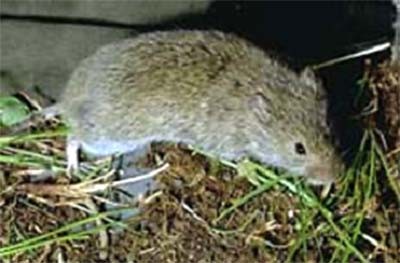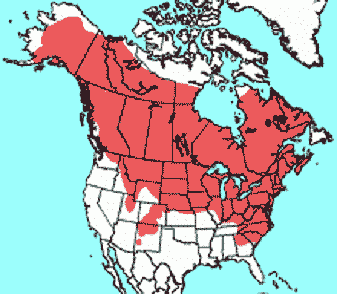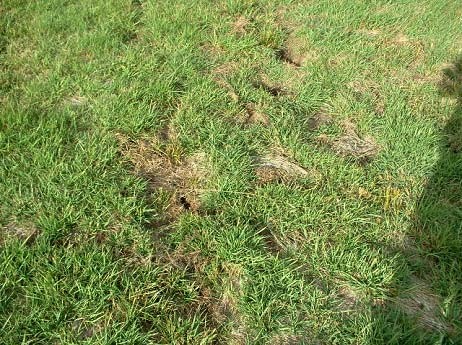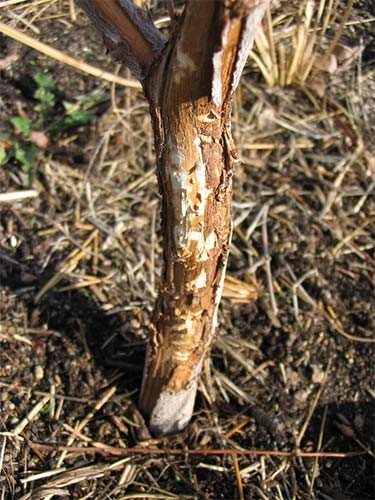Meadow mouse / Microtus pennsylvanicus
Area of Distribution
The meadow vole is the most widely distributed vole species in the United States, and is found in the northern United States and Canada. Its east to west range is continuous from central Alaska to the Atlantic coast. South of the Canadian border, its western limit is the Rocky mountains. It prefers low wetlands, open grasslands, and orchards. When it is in association with the prairie vole or montane vole, it is generally in moister habitats.
Above ground foraging Meadow Vole populations can be controlled using the Vole Control Bait Station System with the Tent Set-up Method.
 Meadow Vole |
 Distribution of the Meadow Vole |
| Pictures from - National Museum of Natural History ©2004 Smithsonian Institution | |
Physical characteristics
The Meadow voles' eyes and ears are visible and are not covered by fur. Its tail is longer than its hind legs. The fur is dark brown and often silvery on the underside. It is slightly larger than the pine vole.
Reproduction
Meadows are the world's most prolific mammals. Females can breed when they are only a month old, and will mate again as soon as they give birth. They can produce an average litter size of 5 every three weeks throughout their entire lives of 1 to 2 years. They are known for their boom-bust population cycles, and at peak density, they are capable of causing considerable damage. Females maintain exclusive territories during the breeding season, and the males are mobile.
Ecology
Meadow voles spend most of their lives above the ground, but can also make shallow tunnels in the ground. They prefer runways in open grass but stay and hide where there is a protective cover from predators such as hawks. Meadow voles mostly eat where they are. That is why the Tent setup with the Vole Control Bait Station is effective in controlling them, because they feel safe while they eat the bait. Sometimes they make baseball size nests of interwoven strands of dry grass to store food, and sometimes they store food in underground nests. From May until August it eats green and succulent vegetation. During the fall it switches to grains and seeds, and during the winter it feeds on the bark and roots of shrubs and small trees. It will also eat tubers and bulbs when available.
 Picture provided by T. Bacchus |
The meadow vole is typically more active during the night, and they have larger home ranges than pine voles. A colony can have runways covering an area as large as a quarter acre and a colony consists of a pair of voles but more likely will include several generations. Meadow voles prefer grassy areas, but can convert a pine vole's tunnel into a runway of their own. Pine and meadow voles don't mix at all. Meadow voles are not as social as pine voles.
Signs of Meadow Vole Activity
The signs of meadow voles are found mostly above ground in taller grasses, lawns and cover. They make a network of surface trails in the grass and grass clippings or thatch that are linked to underground burrows. The surface runways are 1 to 2 inches in width and are often littered with droppings and grass cuttings.
 Picture provided by B. Guddat |
Meadow voles gnaw and girdle trees and saplings at the ground level. Vole gnawing can be differentiated from the gnawing of other animals by the non-uniform gnaw marks. They occur at various angles and in irregular patches. The girdling may be higher in the winter months if snow cover exists.
Rabbits also chew on young trees, but their gnawing begins several inches above the soil line. Rabbits have much larger teeth than voles and their regular gnaw marks on the trees will show this.
When snow cover is present, voles are protected from predators and their activity can go undetected until it is too late. They can damage the trunks and roots of trees by gnawing. The gnaw marks are about 1/16 to 1/8 inch wide and 3/8 inch long found in irregular patches and at various angles. If this gnawing completely surrounds the root or trunk of the tree or shrub, it will kill the plant. This is called girdling.
It is important to act before vole numbers get too high, especially before winter snow provides cover. The damage they can do to ornamental plants, trees, and garden plants can be quite severe and take several years to replace.
Control Recommendation
With their high reproductive potential, any remaining voles could repopulate an area quickly. With this potential for severe damage to your landscape and garden, a homeowner cannot afford to do nothing and assume a predator will control the problem. You must take immediate action to prevent the loss of valuable plantings. Effective action involves using the Vole Control Bait Station System, habitat modification, and regular monitoring in the fall and spring with the "Apple Sign Test" to detect any resurgence from surrounding areas. Pay particular attention to surrounding areas of your property that have heavy vegetation because such areas are likely sources of invasions.